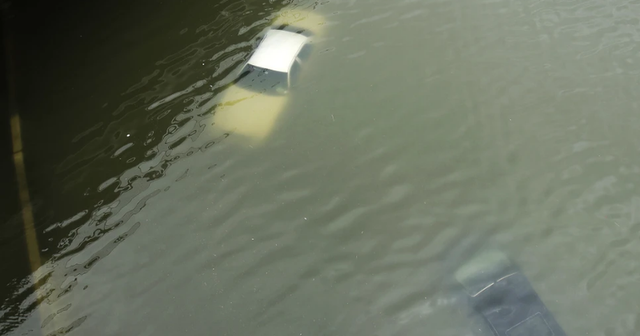
What do forecasters mean when they talk about a 100-year flood?


Weather forecasters sometimes warn of storms that drop rains so unusual that they are described as 100-year or even 500-year floods.
Here's what you need to know about how scientists determine how extreme a flood is and how common these extreme events are becoming.
What does a 100-year flood mean?
Scientists use mathematics to help people understand how unusual a severe flood is, and how to compare the intensity of one flood to another.
According to the U.S. Geological Survey, one statistic scientists use is the percentage chance that a flood of a specific size will occur.
A 500-year flood means that such an event has a 1 in 500, or 0.2%, chance of occurring in a year.
Another concept that scientists use is how often an event of a certain intensity is expected.
For example, a meteorologist might look at the average recurrence interval of a predicted flood and see that a similar event is expected only once every 25 years.
Agencies have preferred to express the percentage chance of a flood occurring rather than the recurrence interval, because this statistic better represents the fact that rare floods can occur within a few years of each other.
It's like rolling a pair of dice and getting sixes twice in a row. It's rare, but statistically possible.
Another term people hear during an impending flood is that it could be a once-in-a-generation or once-in-a-lifetime event, a casual way of saying that a flood could be unlike anything many people have experienced.
How floods are changing with climate
Houston, Texas, was hit by three 500-year floods from 2015 to 2017, according to local officials at the time. The events included Hurricane Harvey, the heaviest rainfall ever recorded in the U.S. Homes and businesses were destroyed, while cars were swept away by the floodwaters.
Although mathematics can calculate how often we should expect floods of specific sizes, nature has its own plans, including irregularities.
Many interconnected systems in the environment, such as local weather patterns and larger events like El Nino, can contribute to changing the likelihood of flooding.
Since the early 1900s, rainfall events have become heavier and more frequent across much of the U.S., and flooding is becoming a bigger problem, according to the National Oceanic and Atmospheric Administration.
Gases emitted by human activities, such as driving cars and growing food, are warming the atmosphere, allowing it to hold more water vapor.
For every 1 degree Fahrenheit that the temperature warms, the atmosphere can hold nearly 4% more water, said Victor Gensini, a professor of atmospheric sciences at Northern Illinois University. That's a 7% increase for every 1 degree Celsius.
That vapor eventually falls back to the ground, as rain or snow. "We've absolutely seen a shift in the probability distribution of heavy precipitation over the last three decades," Gensini said.
Other regions have experienced drought due to changing rainfall patterns.
According to NASA, severe droughts and periods of excessive rainfall have occurred more frequently. Globally, the intensity of extreme wet and dry events is closely linked to global warming.

Rama's mockery of EU integration
ideas

"Who talks about Lulzim Basha anymore?!"

Basha, the surprise of this campaign!

Two Prime Ministers, two worlds
top
Alfa recipes
TRENDING 
services
- POLICE129
- STREET POLICE126
- AMBULANCE112
- FIREFIGHTER128

























